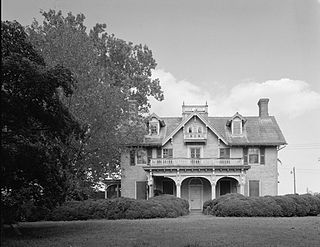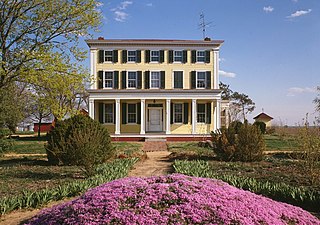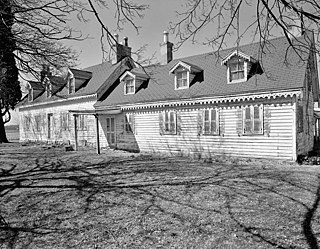
The Corbit–Sharp House is a historic house museum located at 118 Main Street in Odessa, Delaware. Built in 1772–74, it is one of the finest examples of a brick Georgian house in the Mid-Atlantic states. It was declared a National Historic Landmark in 1967, and is included in the Odessa Historic District. It has been a museum, under different ownerships, since 1940.

Meadow Garden is a historic house museum at 1320 Independence Drive in Augusta, Georgia. It was a home of Founding Father George Walton (1749–1804), one of Georgia's three signers of the U.S. Declaration of Independence. Walton was later elected governor of Georgia and also served as a United States senator. Meadow Garden was saved by the Daughters of the American Revolution, who established it as a museum in 1901. The house was declared a National Historic Landmark in 1981.

Old Town Hall is a historic town hall located at Wilmington, New Castle County, Delaware. It was built in 1798, and is a large two-story brick building in a late-Georgian / early-Federal style. The roof is gently sloping and is topped by a large octagonal cupola and once had a wooden balustrade. The building housed the Wilmington city government until 1916 and served as a focal point of many public events in Delaware's history. The property is owned and managed by the Delaware Historical Society

The Cochran Grange, also known as John P. Cochran House, is a historic home located in Middletown, Delaware, United States. It was built between 1842 and 1845, and consists of a two-story, five-bay, main block with a two-story wing. The design is influenced by the Greek Revival, Italianate, and Georgian styles. The house features a two-story porch supported by Doric order columns and a flat roof surmounted by a square cupola. Cochran Grange was the home of John P. Cochran, 43rd Governor of Delaware (1875–1879).

Westend is a temple-fronted house near Trevilians, Virginia, United States. Built in 1849, the house's design refers to the Classical Revival style, representing an extension of the Jeffersonian ideal of classical architecture. The house was built for Mrs. Susan Dabney Morris Watson on a property that she had inherited from her late husband. The building project was supervised by Colonel James Magruder. The house was the centerpiece of a substantial plantation, and a number of dependencies, including slave dwellings, survive. Westend remains in the ownership of the descendants of Mrs. Watson.

James Stewart Jr. House is a historic home located at Christiana, New Castle County, Delaware. It was built in the late-18th century, and is a two-story, five-bay, brick dwelling. It consists of a three-bay, double pile section and a two-bay single pile section. The front facade features a three-bay, one story, hip-roofed facade porch with turned posts and added in the 20th century.

Chelsea is a historic home located in Delaware City, New Castle County, Delaware. It was built in 1848 by Thomas Clark, and is a three-story, three-bay-square brick block with a low, almost flat, hipped roof surmounted by a widow's walk. It is in a regional variation of the Italianate / Greek Revival style. It has a low, one-story wing at the east side, a wide, one-story glass-enclosed front porch and a large, two-story addition to the rear of the house.

Swanwyck is a historic home located near New Castle in New Castle County, Delaware. It was built between 1813 and 1819, and is a two-story, three-bay, stuccoed brick dwelling reflective of the Regency period. The house has been modified by later additions and is now surrounded by 20th century residential development, unlike its original farmland setting.

Greenbank Historic Area is a historic grist mill located at Marshallton, New Castle County, Delaware. The property includes the Greenbank Mill, Robert Philips House, and the W. G. Philips House. The mill was built in 1790 and expanded in 1812. It is a 2+1⁄2 story, frame structure with a stone wing. The mill measures 50 feet (15 m) by 39 feet (12 m). The Robert Philips House was built in 1783, and is a 2+1⁄2 story, five-bay, stone dwelling with a gable roof. The front facade features a long verandah. The W. G. Philips House, also known as the mill owner's house, dates to the mid-19th century. It consists of a two-story, three-bay front section with a three-story, hipped roof rear section. Oliver Evans, a native of nearby Newport, installed his automatic mill machinery in the 1790 building.

Greenlawn, also known as the Outten Davis House and William Brady House, was a historic home located at Middletown, New Castle County, Delaware. It was built about 1810, and radically altered about 1860. It was a two-story, five-bay, brick dwelling with cross-gable roof with dormers. It had a rear brick ell with attached wing. It featured a three-bay front porch, large brackets, a widow's walk on the roof, and ornate chimney caps. It was originally built in the Late Georgian style, then modified with Late Victorian details.

Arnold S. Naudain House is a historic home located near Middletown, New Castle County, Delaware. It was built about 1725, and is a 2+1⁄2-story, five-bay, stuccoed brick dwelling in the early Georgian style. It has a hipped roof and two-story stuccoed brick wing. Also on the property is a contributing ice house.

Hedgelawn, also known as the Kohl House, was a historic home located near Middletown, New Castle County, Delaware. It was built in 1856, and is 2+1⁄2-story, five-bay, clapboard-clad frame dwelling with a flat roof. It is L-shaped. The design was influenced by the Greek Revival, Italianate, and Georgian styles. Also on the property was a contributing hipped roof privy. Hedgelawn was the home of William R. Cochran, son of John P. Cochran, 43rd Governor of Delaware (1875–1879). Prior to its demolition, the nearby Rumsey Farm house was almost identical to Hedgelawn.

Achmester was a historic home and national historic district located near Middletown, New Castle County, Delaware. It encompassed four contributing buildings and two contributing structures. Achmester was built in 1829, and was a 1+1⁄2-story, single pile "Peach Mansion." It consisted of a five bay frame main block with a five bay gable end addition, and five bay rear service ell. It had a gable roof with dormers and sat on a stone foundation. The façade featured simple box cornices and dormers decorated at a later date with Gothic Revival sawnwork trim, pendents, and vergeboards. The contributing outbuildings consist of a cow barn, shed, milk house, granary, and smokehouse. It was built by Richard Mansfield, a founder of Middletown Academy.

Monterey is a historic home located near Odessa, New Castle County, Delaware. It was built about 1850, and is a two-story, five bay brick house with an original ell to the rear and a frame, two-story addition to the extreme rear. It is of full Georgian plan - center hall, double pile and in the Greek Revival style. It has a one-bay entrance portico with a flat-roof and balustraded parapet. Also on the property are a contributing smokehouse, carriage house, ice house, granary, and frame octagonal privy.

Starr House, also known as the Michael VanKirk House, is a historic home located at Wilmington, New Castle County, Delaware. It was built between 1801 and 1806, and is 2+1⁄2-story, brick dwelling with a gable roof. The house was restored in 1946 and considered the last example of colonial architecture in the city of Wilmington. Adjacent to the house is a mid-19th century frame summer kitchen, which contains a beehive oven, has been encased in brick.

Woodstock, also known as Banning Park, is a historic home located at Wilmington, New Castle County, Delaware. The house was restored in 1929. The "Woodstock" house stands at the highest point of the park. From this height can be seen the Delaware and Christina rivers and their surrounding marshes. The house is of brick, with a two-story east wing said to have been built in 1743, and a two-and-one half story west wing built-in 1833. The addition of porches and a kitchen shed during the 1930s are the only modern changes. On the roof of the newer and taller wing is a "widow's walk" surrounded by a balustrade.

Walker's Mill and Walker's Bank, also known as Simsville, Siddall's Mill, and "Big White Mill", is a historic spinning cotton mill and worker's dwelling block located near Wilmington, New Castle County, Delaware. Walker's Mill was built between 1813 and 1815, and is a 2+1⁄2-story, T-shaped, stone building.

Philips-Thompson Buildings was a set of two historic commercial buildings located at Wilmington, New Castle County, Delaware. They were built about 1884, and were two three-story, red brick buildings. They had a row of square decorative terra cotta tiles divides the second and third stories. They featured a corbelled brick cornice and sunburst decorations capping the central bays. The buildings housed a wholesale farm supply company, wholesale grocers and produce shops. The buildings have been demolished.

Lobdell Estate, Minquadale Home, also known as the Minquadale Home for Aged Men, was a historic home and retirement home located at Minquadale near Wilmington, New Castle County, Delaware. It was built in 1864, and was a two and a half-story, five bays wide, stuccoed, and gable-roofed dwelling in the Italianate style. It featured large decorative brackets and a large cupola atop the roof. It was originally built by George Lobdell, a manufacturer of car wheels, as a summer home. In 1891, his vacation house was made over into a retirement home for Lobdell's employees of both sexes.

The Edward Wells House is a historic house at 61 Summit Street in Burlington, Vermont. Built in 1891–92 for the president of a patent medicine maker, it is one of the city's finest examples of Queen Anne Victorian architecture executed in brick and stone. It was listed on the National Register of Historic Places in 1979. The house was for many years home to the Delta Psi fraternity; is now owned by the University of Vermont.
























